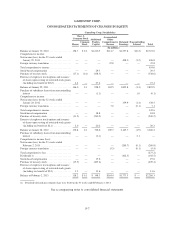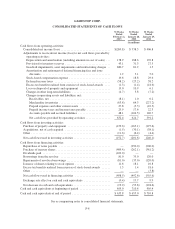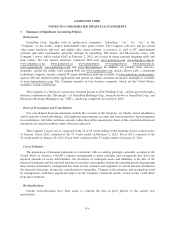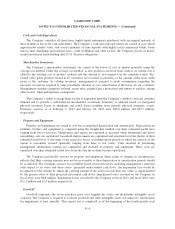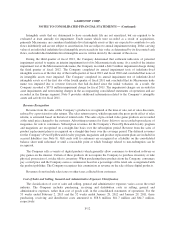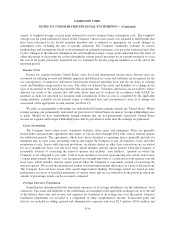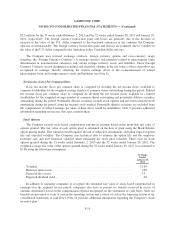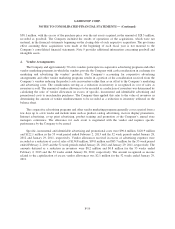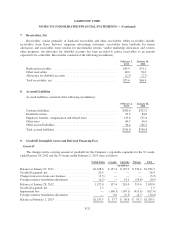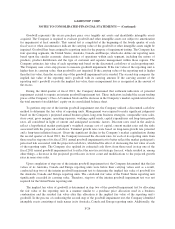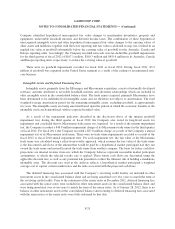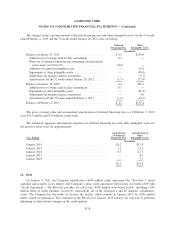GameStop 2012 Annual Report Download - page 92
Download and view the complete annual report
Please find page 92 of the 2012 GameStop annual report below. You can navigate through the pages in the report by either clicking on the pages listed below, or by using the keyword search tool below to find specific information within the annual report.
GAMESTOP CORP.
NOTES TO CONSOLIDATED FINANCIAL STATEMENTS — (Continued)
During the first quarter of fiscal 2012, we adopted the accounting standard update regarding fair value
measurement and disclosure. This accounting standard update was issued to provide a consistent definition of fair
value and ensure that the fair value measurement and disclosure requirements are similar between GAAP and
International Financial Reporting Standards. This accounting standard update also changes certain fair value
measurement principles and enhances the disclosure requirements particularly for Level 3 fair value
measurements. The adoption of this accounting standard update did not have a significant impact on our
consolidated financial statements.
In September 2011, an accounting standard update was issued related to testing goodwill for impairment.
The purpose of the update is to simplify the guidance for testing goodwill for impairment and the update permits
entities to first assess qualitative factors to determine whether it is necessary to perform the quantitative
impairment test. An entity will no longer be required to calculate the fair value of a reporting unit unless the
entity determines, based on a qualitative assessment, that it is more likely than not that its fair value is less than
its carrying amount. This standard did not have an impact on our annual goodwill impairment testing process in
fiscal 2012 as we did not elect to perform a qualitative assessment. The adoption of this guidance may result in a
change in how we perform our goodwill impairment assessment; however, it will not have a material impact on
our consolidated financial statements.
2. Asset Impairments and Restructuring Charges
During the third quarter of fiscal 2012, the Company recorded a $44.9 million impairment charge as a result
of the Company’s interim impairment test of its Micromania trade name. The fair value of the Micromania trade
name was calculated using a relief-from-royalty approach, which assumes the fair value of the trade name is the
discounted cash flows of the amount that would be paid by a hypothetical market participant had they not owned
the trade name and instead licensed the trade name from another company. Refer to Note 9, Goodwill, Intangible
Assets and Deferred Financing Fees, for further information associated with the trade name impairment. In fiscal
2012, the Company also recorded impairments of definite-lived assets of $8.8 million, consisting primarily of the
remaining net book value of assets for stores the Company is in the process of closing or that the Company has
determined will not have sufficient cash flow on an undiscounted basis to cover the remaining net book value of
assets recorded for that store. The Company used a discounted cash flow method to estimate the present value of
net cash flows that the fixed asset or fixed asset group is expected to generate in determining its fair value. The
key inputs to the discounted cash flow model generally included our forecasts of net cash generated from
revenue, expenses and other significant cash outflows, such as capital expenditures, as well as an appropriate
discount rate. There were no restructuring charges for the 53 weeks ended February 2, 2013.
A summary of the Company’s asset impairments for the 53 weeks ended February 2, 2013 is as follows:
United States Canada Australia Europe Total
(In millions)
Intangible asset impairment ............................ $— $— $— $44.9 $44.9
Property, equipment and other asset impairments ........... 5.7 0.4 0.2 2.5 8.8
Total .............................................. $5.7 $0.4 $0.2 $47.4 $53.7
In the fourth quarter of fiscal 2011, the Company recorded asset impairments and restructuring charges of
$81.2 million, of which $37.8 million was recorded as a result of the Company’s annual impairment test of its
Micromania trade name. The fair value of the Micromania trade name was calculated using a relief-from-royalty
approach, which assumes the fair value of the trade name is the discounted cash flows of the amount that would
be paid by a hypothetical market participant had they not owned the trade name and instead licensed the trade
name from another company. Refer to Note 9, Goodwill, Intangible Assets and Deferred Financing Fees, for
F-17


